The big interview: Margot Robbie’s Papa Salt Gin
By Georgie CollinsThe five film-set friends behind Papa Salt tell The Spirits Business how they blended their worlds to create a coastal gin that is already making waves beyond the beach.
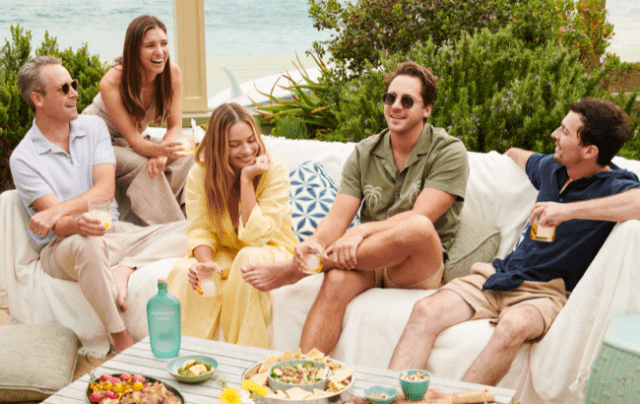
*This feature was first published in the May issue of The Spirits Business magazine.
It’s May 2023, and Margot Robbie has just become the latest celebrity to launch a spirit brand. You may have heard the collective sigh from the industry. Another one, really? Except the I, Tonya actress hadn’t done it alone, and her brand, Papa Salt Coastal Gin, was not just another cash grab from a clueless side‐ hustling celeb. Rather, the brand was created in equal partnership with her four gin‐loving friends: her husband, actor and film producer Tom Ackerley; Saltburn producer Josey McNamara; associate producer Regan Riskas; and Riskas’ husband, drinks industry veteran Charlie Maas – the group’s pivotal link to the world of spirits.
“I worked for my dad and grandpa for eight years building the RumChata [cream liqueur] brand,” explains Maas, who helms Papa Salt as CEO. “We sold about 50 million bottles, mostly in the US, and Regan and I moved to the UK in 2017 to launch the brand in Europe.”
The story begins
Maas says it was around the same time that the Papa Salt story began. “Regan worked with Margot on Whiskey Tango Foxtrot, and then we met Tom and Josey. We all stayed friends. That was back in 2015, and then when they reached out to me and said, ‘hey, we were looking for another thing to do, and we only really like movies and drinking, so can you explain to us what it would be like if we wanted to make a gin?’ we sat down and talked through what the process would be like.”
Maas’s background in spirits, while an asset to the business, was not the be‐all and end‐all for the quintet when it came to creating the brand. “That helped,” he says, “but the fact that we were all friends first, and there was a familiarity there between the team, helped get everything done.”
He explains the brand was conceived in 2018, but it wasn’t until 2023 that it made its market premiere: “As the guy running it, I had to be comfortable with the fact that we might not have a meeting for five months because the team was going off to make a movie.” As such, Maas says, had they not had the foundations of friendship to keep drawing them back in, Papa Salt would likely never have come to fruition. “The two things were integral – yes, to have someone with spirits experience, but we all had to be friends, too, so we could take it as slowly as we did.”
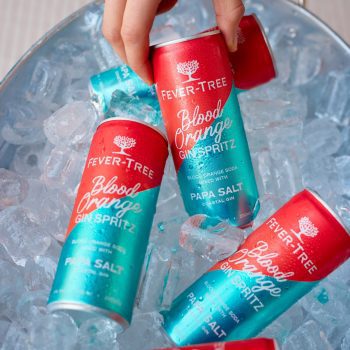
Robbie adds that what could have seemed daunting for both her and the group – embarking on an entirely new project away from the world of entertainment – was actually made easier on account of her acting career, and the fact they were “just five friends who love drinking gin together”. “Creating things with my friends is what I’ve been calling ‘work’ for the last 10 years, so this just feels like a continuation of that in a new realm. It never felt daunting because we didn’t actually have to do it. No one came to us and asked us to create a gin, so we didn’t have to answer to anyone but ourselves.”
Five heads are, of course, a lot harder to unite than two or three. Luckily, the group agrees they were all reading from the same script when it came to what they wanted Papa Salt to be. “At the beginning, Charlie bought all the market‐leading gins,” Ackerley explains, “and as a group, we blind tasted them. We were testing to see: are we all looking for the same thing here? Because if we’re not, we’ll never get to a final thing.”
Through this process, the group settled on a few expressions they all loved, all with very similar flavour profiles. This confirmed that a contemporary gin was what they were all aiming for. “We wanted to make a new‐style gin that was versatile and ‘sessionable’ – something you could sit in the sun and drink with your friends,” Maas says.
Once this was agreed upon, the freedom to explore botanicals arrived, which was one of the other contributing factors to the slower route to market. One direction they explored was the infusion of a rooibos teabag into the gin – a move inspired by Robbie’s solution to a bad Gin & Tonic. “We used to drink a lot of G&Ts in London, and if we had one that wasn’t very well made, to mask it she’d add a rooibos teabag – that was kind of her thing,” Ackerley says about his wife, while noting that if he’d had his way, dill would have been a prominent botanical explored. “We didn’t go down that road,” he confirms, “but we had a lot of freedom to individually explore, all knowing that the group’s main goal was a unified flavour profile.”
However, Maas notes the main goal wrapped within a sessionable spirit was almost lost along the way. “We had that in mind pretty early on, and then we went in some pretty crazy directions,” such as the teabag idea, he says. “We actually took that recipe all the way to where we thought it was done, and then we threw it out.” The team recalls a tasting they did with some friends, one of whom runs spirits tasting competitions. Maas recalls the friend saying the gin would win were it entered, however after the tasting, when the friends stayed for another G&T or two, nobody reached for the gin “because it wasn’t versatile or accessible. It was a very specific flavour profile, and we realised we didn’t make the thing we said we were going to make, so we had to toss it and start over.”

Competition time
Together, the group estimates they tried 300 iterations in the R&D stage, with their distiller creating 59 official recipes. “We would have probably taken another five years had Charlie not anonymously entered us into our first competition, which we won,” Ackerley says. “Then we were like, OK, well, maybe we’ll add a little bit more rosemary, and Charlie said: ‘Nope, we’ve won this. That’s a good enough signifier for us.’ It’s like we always say when you’re editing a movie, you could keep going forever; eventually someone just has to say it’s done. That was Charlie’s role. Charlie was the producer.”
Entering competitions has done more for the brand than simply confirm the gin’s final recipe. More than anything, it has allowed Papa Salt to stand out as an exemplary product beyond the famous name associated with it, achieving Gold at the San Francisco World Spirits Competition in 2024, and Best in Show at the 2022 LA Spirits Awards. “We always set out to make a gin that would stand well on its own, that would be received well, that tasted wonderful, and that we were proud to share with the world,” explains Riskas.
“And we’ve been very careful to put the bottle, branding, and our story first. Certainly, having Margot attached is a wonderful thing, but we were very careful to craft the narrative around the product first.”
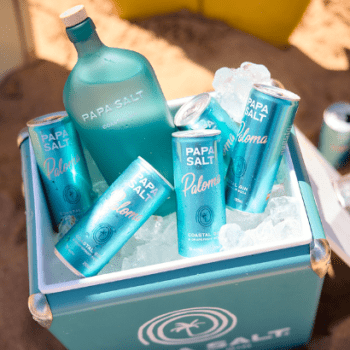
Maas adds: “We’re five friends that just love gin, and one of them happens to be a very famous person. We’ve tried to make it more about the gin and our love for it – we want people to realise that we’re here because of the product, and we made it.” However, he recognises that having Robbie involved gives the brand a captive audience. “We know we can garner that attention as a brand, but what we really want to do, once we get people’s attention, is to let them know about the quality of the product, and the care we took to make it,” he says.
It’s unclear whether consumers have taken onboard that messaging yet, however, while the involvement of the Barbie superstar likely contributed to the product selling out within 48 hours of its Australian launch, it seems that more than just her association with the brand has been behind its success. The brand has gone on to shift around 8,000 nine‐litre cases globally since its debut, launch a canned ready‐to‐drink (RTD) Paloma cocktail in travel retail with Virgin Australia, and secure shelf space in 900 Tesco stores in the UK. Furthermore, the brand has also received the approval of Fever‐Tree, which has hitched its mixers wagon to the gin in a partnership that has seen the launch of a canned Blood Orange Spritz. “We were so thrilled when Fever‐Tree said, ‘yeah, let’s do this’ because we knew the consumer would see that and know Papa Salt is a premium product, even though it is in a can,” Maas says.
An Australian brand
Papa Salt is first and foremost an Australian brand, and the link to the country is obvious – Robbie was born and raised in Queensland, and began her acting career on the long‐ running soap opera Neighbours, but there are additional reasons why the five founders chose to produce the spirit there.
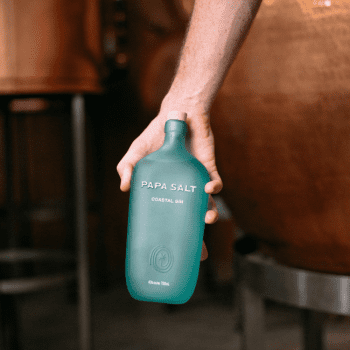
“When we started thinking of the brand, we wanted to make this outdoor/sunshine/day‐ drinking premium gin that reflected the beachy lifestyle, so it was pretty clear that we wanted to make it in Australia,” Maas confirms. “I also think that if you look at the gins that have come out of Australia in the past 10 years, they have really interesting ingredients, really vibrant flavour profiles. I mean, there’s so many wonderful gin producers in Australia in particular, and so we kind of looked at the entire package and said, well, it seems like we’re trying to make a beachy Australian gin.”
But producing gin in Australia comes at a high cost. As it stands, the country’s spirits duty is set at AU$104.31 (US$67) per litre of pure alcohol, a figure that has risen by 16% in the past three years in line with the Consumer Price Index. This, Maas notes, is the “highest excise tax on spirits in the world”. But the team knew this going in, and decided the financial burden that comes with Australian spirits production was outweighed by the benefits, such as the ability to incorporate native botanicals, including wattle seed, oyster shell, and wax flower alongside pink peppercorn, hibiscus and citrus peel, all of which give the gin a bright and fresh flavour profile that is rounded off with an unmistakable yet subtle salinity.
Expansion on the cards
The gin was developed in partnership with Lord Byron Distillery in Byron Bay – a zero‐ waste facility that operates on renewable energy. The site can produce 300,000 litres of Papa Salt annually, although the film‐set friends are looking at another space that would allow them to drastically expand, but they are set on keeping production in Byron Bay. “We found a great partner in Lord Byron Distillery, and they helped guide and shape the beautiful botanicals, so it’s the perfect place for us,” Riskas says.
Ackerley points out that they know it doesn’t always make the most sense from a business perspective to produce in Australia, but the intention is to scale up the production there: “While we can surely make a similar product overseas, I think we’ve never wanted to cut a corner on it, and so as long as we don’t have to pass that cost on to the consumer, we’ll continue doing that.”
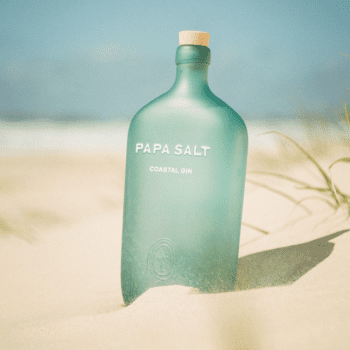
Riskas adds: “And it’s also a coastal gin, and what more beautiful place than Byron Bay to have it be made? And the bottle really resembles the water there – it’s literally a colour match to the ocean, taken from a picture Margot took when she was there.”
That resulting bottle, which is intentionally simple, is also beautiful. The frosted blue glass and smooth shape make it very tactile to hold, and with only the essential information written on it, it offers a simplicity that makes it even more eye catching, especially on a back bar.
“The bottle really beautifully reflects everything we hope to do with the brand – be premium but accessible for anyone,” Maas states.
As the brand approaches its second birthday, the team is considering the avenues it could take to accelerate growth and further its success. Maas clarifies: “Like the rest of the industry, we’re interested in case sales as a catch‐all metric – and our focus is on growing those numbers as much as possible. Like any business, we need to be smart about the bottom line, but we try to make sure we invest money anywhere we can drive incremental volume.”
At the moment, that looks like more strategic partnerships with mixer brands. “We would love to do more with Fever‐Tree,” he adds. “We think they’re a great team, and those mixers are amazing. And as we look around the world, the question is always going to be how can we make sure consumers know that what’s in this can is really premium, and that sort of partnership is probably our answer to that question.”
Riskas adds: “In terms of the gin itself, we’ve always set out to just do that as best we can, and make that the shining star. We’ve had a lot of people ask if we’re going to do variations or different flavours of it, and right now we’re just focused on keeping that our primary focus.
“These collaborations with the RTDs have been so wonderful and such a fun way to show people how to drink it on the go, but we’re also just so proud of Papa Salt on its own.”
Robbie says: “We always said if [having a gin brand] ever stopped being fun we wouldn’t do it anymore. By those terms, it feels successful already.”
Related news
The big interview: Carlie Dyer, Starward
